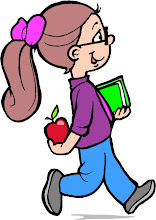We continued with Bedtime Math (almost) everyday.
We spent four days on lesson four of Professor Pig. This lesson teaches how to break numbers into 5's for adding and to find 10's when adding. We played the games from this lesson, and from the previous lessons.
We started playing the games in
Family Math by Stenmark, Thompson, and Cossey. Each Friday we played a different game. The game we have enjoyed most is
Target Addition. This game consists of a grid 5 squares by 5 squares. The bottom row of squares all have the number 1 in them. The next row up is 2, the next row is 3, then 4, then 5. One player picks a number between 25 and 55. Then players take turns putting a token on numbers until the "picked number" is reached. The person who puts the last token on is the winner. The first day we played this three times -- K. won all three games. I have only won twice in all the games we've played. This game is good for addition practice and strategy.
I purchased the book,
Teaching Math with Favorite Picture Books by Hechtman and Ellermeyer. It has 28 books and hands-on activities to use to teach math. The four books we did during this set are listed here:
- The Quilt Story by Tony Johnston
- Billy's Button by William Accorsi
- Caps for Sale by Esphyr Slobodkina
- The Greedy Triangle by Marilyn Burns
- Ed Emberley's Picture Pie by Ed Emberley
To go along with
The Greedy Triangle, I found some work sheets on-line that dealt with angles -- right, acute, or obtuse.
I used
Picture Pie to introduce our week of fractions. Then we started working through a workbook on fractions. This is just a part of a book that I was able to download for free. It is from
www.aplustutorsoft.com. We did four lessons of review, then introduced equivalent fractions, along with some games from
Fabulous Fractions (Fraction Strips and Fraction Match).
For the last week of Set Two, I wrote five addition problems and five subtraction problems on 3 x 5 cards. The addition were 3 numbers up to 10,000 place. The subtraction were also up to 10,000 place. After K. solved the problems, I cut the answers off and we:
- put them in numerical order
- told what the number would be if it was 10 more/10 less, etc.
- place value; told what numeral was in the ______ place
- compared the numbers using < and >
- grouped them by even and odd
- rounded to the nearest ten, hundred, and thousand
- introduced the expanded form; 382 = 300 + 80 + 2


